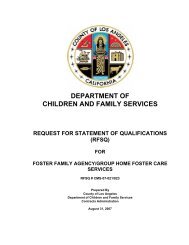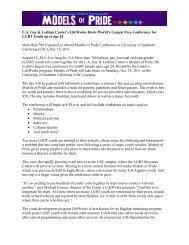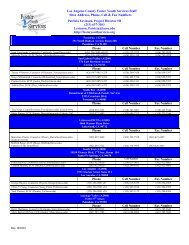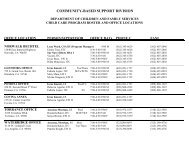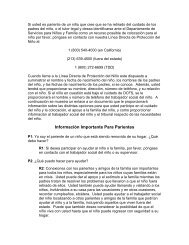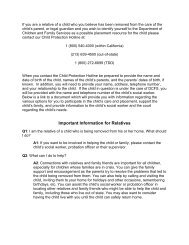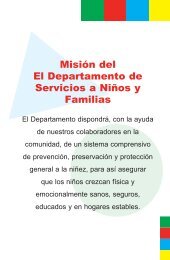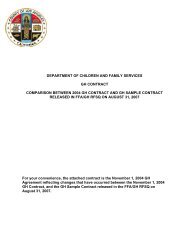Phases and Activities of the Wraparound Process - Los Angeles ...
Phases and Activities of the Wraparound Process - Los Angeles ...
Phases and Activities of the Wraparound Process - Los Angeles ...
You also want an ePaper? Increase the reach of your titles
YUMPU automatically turns print PDFs into web optimized ePapers that Google loves.
<strong>Phases</strong> <strong>and</strong> activities <strong>of</strong> <strong>the</strong> wraparound process 12<br />
MAJOR TASKS/Goals ACTIVITIES NOTES<br />
3.2. Revisit <strong>and</strong> update <strong>the</strong> plan<br />
GOAL: To use a high quality team<br />
process to ensure that <strong>the</strong><br />
wraparound plan is continually<br />
revisited <strong>and</strong> updated to respond<br />
to <strong>the</strong> successes <strong>of</strong> initial<br />
strategies <strong>and</strong> <strong>the</strong> need for new<br />
strategies.<br />
3.3. Maintain/build team<br />
cohesiveness <strong>and</strong> trust<br />
GOAL: To maintain awareness <strong>of</strong><br />
team members’ satisfaction with<br />
<strong>and</strong> “buy-in” to <strong>the</strong> process, <strong>and</strong><br />
take steps to maintain or build<br />
team cohesiveness <strong>and</strong> trust.<br />
3.1. d. Celebrate successes<br />
The facilitator encourages <strong>the</strong> team to acknowledge <strong>and</strong><br />
celebrate successes, such as when progress has been<br />
made on action steps, when outcomes or indicators <strong>of</strong><br />
success have been achieved, or when positive events or<br />
achievements occur.<br />
3.2. a. Consider new strategies as necessary<br />
When <strong>the</strong> team determines that strategies for meeting<br />
needs are not working, or when new needs are<br />
prioritized, <strong>the</strong> facilitator guides <strong>the</strong> team in a process <strong>of</strong><br />
considering new strategies <strong>and</strong> action steps using <strong>the</strong><br />
process described in activities 2.1.f <strong>and</strong> 2.1.g.<br />
3.3 a. Maintain awareness <strong>of</strong> team members’<br />
satisfaction <strong>and</strong> “buy-in”<br />
Facilitator makes use <strong>of</strong> available information (e.g.,<br />
informal chats, team feedback, surveys—if available) to<br />
assess team members’ satisfaction with <strong>and</strong> commitment<br />
to <strong>the</strong> team process <strong>and</strong> plan, <strong>and</strong> shares this<br />
information with <strong>the</strong> team as appropriate. Facilitator<br />
welcomes <strong>and</strong> orients new team members who may be<br />
added to <strong>the</strong> team as <strong>the</strong> process unfolds.<br />
3.3 b. Address issues <strong>of</strong> team cohesiveness <strong>and</strong><br />
trust<br />
Making use <strong>of</strong> available information, facilitator helps team<br />
maintain cohesiveness <strong>and</strong> satisfaction (e.g., by<br />
continually educating team members—including new<br />
team members—about wraparound principles <strong>and</strong><br />
activities, <strong>and</strong>/or by guiding team in procedures to<br />
underst<strong>and</strong> <strong>and</strong> manage disagreement, conflict, or<br />
dissatisfaction).<br />
A Product <strong>of</strong> <strong>the</strong> National <strong>Wraparound</strong> Initiative – October 10, 2004 version<br />
Acknowledging success is one way <strong>of</strong> maintaining a<br />
focus on <strong>the</strong> strengths <strong>and</strong> capacity <strong>of</strong> <strong>the</strong> team <strong>and</strong> its<br />
members. Successes do not have to be “big”, nor do <strong>the</strong>y<br />
necessarily have to result directly from <strong>the</strong> team plan.<br />
Some teams make recognition <strong>of</strong> “what’s gone right” a<br />
part <strong>of</strong> each meeting.<br />
Revising <strong>of</strong> <strong>the</strong> plan takes place in <strong>the</strong> context <strong>of</strong> <strong>the</strong><br />
needs identified in 2.1.d. Since <strong>the</strong> needs are in turn<br />
connected to <strong>the</strong> mission, <strong>the</strong> mission helps to guide<br />
evaluation <strong>and</strong> plan revisions.<br />
Many teams maintain formal or informal processes for<br />
addressing team member engagement or “buy in”, e.g.<br />
periodic surveys or an end-<strong>of</strong>-meeting wrap-up activity. In<br />
addition, youth <strong>and</strong> family members should be frequently<br />
consulted about <strong>the</strong>ir satisfaction with <strong>the</strong> team’s work<br />
<strong>and</strong> whe<strong>the</strong>r <strong>the</strong>y believe it is achieving progress toward<br />
<strong>the</strong>ir long-term vision, especially after major strategizing<br />
sessions. In general, however, this focus on assessing<br />
<strong>the</strong> process <strong>of</strong> teamwork should not eclipse <strong>the</strong> overall<br />
evaluation that is keyed to meeting identified needs <strong>and</strong><br />
achieving <strong>the</strong> team mission.<br />
Teams will vary in <strong>the</strong> extent to which issues <strong>of</strong><br />
cohesiveness <strong>and</strong> trust arise. Often, difficulties in this<br />
area arise from one or more team members’ perceptions<br />
that <strong>the</strong> team’s work—<strong>and</strong>/or <strong>the</strong> overall mission or<br />
needs being currently addressed—is not addressing <strong>the</strong><br />
youth <strong>and</strong> family’s “real” needs. This points to <strong>the</strong><br />
importance <strong>of</strong> careful work in deriving <strong>the</strong> needs <strong>and</strong><br />
mission in <strong>the</strong> first place, since shared goals are<br />
essential to maintaining team cohesiveness over time.



